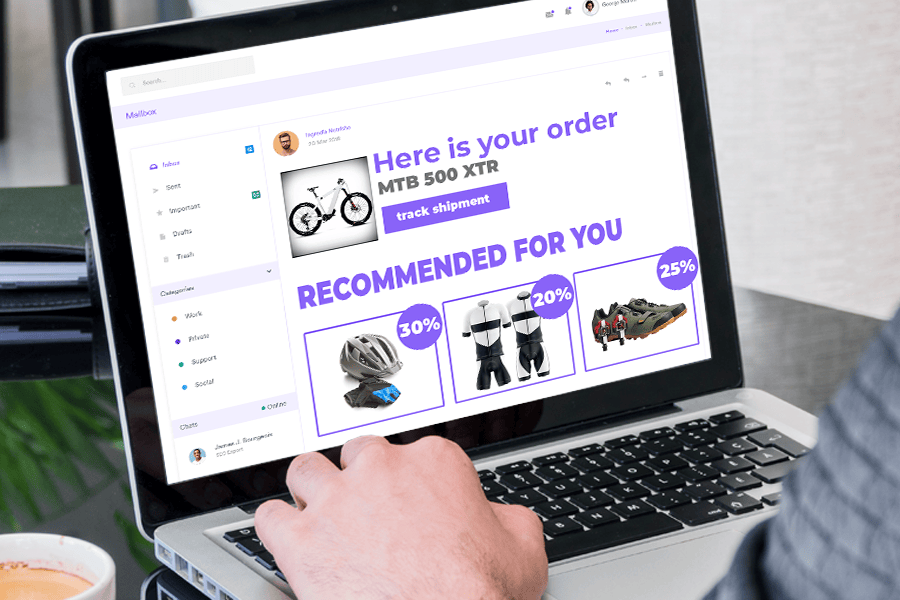
How often does it happen that users add items to their cart without completing the purchase? The reasons can be many: they found a better deal or simply their browsing experience wasn’t personalised for them.
All of this results not only in a missed conversion but, above all, in an increase in acquisition costs.
Very often, all marketing efforts and budget investments are focused on acquiring new customers, completely overlooking the customers we already have and who know us. Through re-engagement strategies, we can reactivate them, nurture them, and rekindle their interest, eventually driving them to conversion.
By running re-engagement campaigns, it will be possible to build stronger relationships, improve loyalty, and increase the average cart value per customer.
Improving customer loyalty also improves two key metrics that impact long-term business growth: revenue and lifetime value.
How to identify inactive customers
Before engaging in any reactivation activity, it’s essential to identify who our inactive customers are.
When we talk about inactive customers, we refer to those who no longer respond to your sales and marketing prompts and, therefore, no longer make purchases from you.
Below are a few signs that can help identify an inactive customer, in particular:
- they haven’t made a purchase in a while;
- lack of engagement or interaction with marketing campaigns;
- high incidence of abandoned carts;
- no interaction with loyalty programs or promotions.
Once inactive customers are identified and segmented, we can send them highly personalised messages and distinguish them from other users, for example, by differentiating them from a high-value audience segment. Analysing customer behaviour reveals why they lost interest, whether it’s too many returns, irrelevant marketing, or other reasons, so we can create tailored strategies to win them back.
Thanks to identity resolution processes, Blendee provides a clear view of inactive customers, making it easier to create targeted segments for re-engagement.
5 strategies for re-engaging inactive customers
Once inactive customers are identified, it’s time to focus on re-engaging them. Below are 5 strategies to reactivate customers:
1. Creating AI-based personalisation activities
AI technology has revolutionised the way we understand and interact with customers, making it easier than ever to re-engage inactive users. Artificial intelligence analyses past customer behaviour and, through predictive algorithms, provides insights on how to reactivate them. For example, it might send a discount email to someone who browsed but didn’t buy, or reach out to customers on social media with a tailored message.
Blendee takes this a step further with real-time personalisation campaigns. From emails and personalised SMS to social media and in-app messaging, Blendee ensures communication is consistent, relevant, and impactful on every channel, tailored to each customer.
2. Leveraging email marketing campaigns
Email marketing remains one of the most valuable channels for reaching customers.
Blendee elevates your email marketing. Whether it’s perfecting subject lines or timing the send at the right moment, Blendee ensures re-engagement emails arrive at the perfect time, turning ordinary opens into sales that will make your team smile.
3. Using SMS and push notifications to leverage scarcity
SMS and push notifications are the perfect means to create urgency and stimulate user interest. Whether customers are scrolling through social media, texting, or browsing the app, Blendee ensures the message arrives at the right time and on the right channel. Additionally, with audience targeting, your campaigns hit the mark without being intrusive.
4. Creating loyalty rewards and incentives
Customer loyalty is the Holy Grail of e-commerce. While a well-placed Instagram ad might get someone to click the CTA, keeping that same customer engaged with the brand is trickier. Blendee makes loyalty programs highly personalised. If a customer loves eco-friendly products, Blendee could send them discounts on sustainable items. This approach makes rewards more relevant and helps bring customers back.
5. Retargeting with personalised ads
Ever noticed an ad for something you recently saw? That’s retargeting, where ads remind customers of the brand after they’ve left your site. Whether it’s Google, LinkedIn, or shopping apps, these personalised ads create a push, encouraging shoppers to return and complete their purchases.
Dynamic retargeting makes personalisation even better. Imagine a customer adds shoes to their cart but doesn’t check out. A timely ad showing those same shoes with a message like “Still thinking about these? They’re waiting for you!” could bring them back, especially with a time-limited discount.
Metrics and KPIs to measure campaign results
Once re-engagement campaigns are launched, it’s important to monitor results to see how they’re performing and, most importantly, whether customers are responding in terms of ROI.
Here are the key KPIs to track in re-engagement campaigns:
- Click-through rate (CTR): it measures the percentage of customers who click on emails, ads, or notifications.
- Conversion rate: it tracks the number of users who complete desired actions, such as purchases or loyalty program sign-ups.
- Retention rate: it shows how many customers return to make purchases over time.
- Average order value (AOV): it reflects how much customers spend per transaction.
- Customer lifetime value (CLV): it evaluates the total revenue generated by a customer throughout their relationship with the brand.
Examples of Customer Reactivation Campaigns
Let’s look at a couple of email examples that can help recover these types of users. Remember, in addition to suggested products, we can pique the curiosity of our customers with content that’s particularly relevant to them. If our site sells recurring products, we could base recommendation algorithms on the most frequently purchased items by that user.

If, on the other hand, we are not talking about consumer products, we could focus, for example, on what is new with regard to brands or categories purchased last time.
As we’ve seen, this is a simple yet effective strategy for quickly and consistently recovering a group of users that we might risk losing and that we could have to “re-buy” through traditional acquisition channels in the future.
Contact us for more information.

